
A while back now, FiiO released their X3 portable music player (or digital audio player / DAP). The original X3 was a bit rough-looking and had an odd button layout, but offered undeniably good sound, especially compared to an iPod or similar mainstream player. Now, after releasing the X5 and X1, FiiO has come back to release an updated, 2nd generation, version of the X3 and it looks the goods!
The unit I’m reviewing was provided courtesy of FiiO and Head-Fier, Brooko, as part of an Australia / New Zealand tour so thank you to both FiiO and Brooko for this opportunity! This unit is clearly marked as a review unit, but appears to be 100% production quality.
Overview
For a retail price of roughly $260 here in Australia, the X3K (as the 2ng gen X3 was known for a while) is a genuine bargain for a native DSD capable DAP boasting a comprehensive feature set. The biggest question for me though was how it would sound, but before we get to that, let’s look at some of the features and specs.
Specifications
- Dimensions: 97mm x 58mm x 16mm
- Weight: 135g
- Output: 3.5mm stereo jack
- Recommended loads: 16 – 150 ohms
- Power: >200 mW to 32 ohms
- Line out: 3.5mm stereo jack (shared with coaxial)
- Line out level: 1.45 Vrms
- Coaxial out: 3.5mm jack with adapter to coaxial RCA (shared with line out)
- Supported formats: DSD64, DSD128, APE, FLAC, WAV, WMA, ALAC, MP3, AAC, OGG
- Sample rates and bit depth: up to 192kHz and 24-bit for lossless PCM formats (FLAC, WAV, etc.)
- Graphic EQ: 10 band
- THD: <0.001%
- Crosstalk: >102dB
- Signal-to-noise ratio: >114dB (A weight)
- Battery life: >11 hours (into a 32 ohm load with screen off)
There is no doubt that the engineers at FiiO know how to create technically excellent players and all of the specs here check out and suggest an incredibly proficient player, particularly when considering the price tag. Let’s check out some of the other bits and pieces before we discuss subjective topics like sound quality.
Design and Functionality
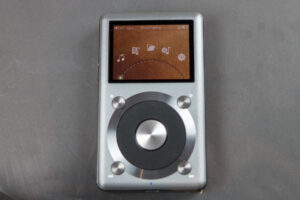 The X3K (not the official name for the 2ng gen, but I will use it here to prevent confusion with the original X3) is beautifully built, much like the X1. With each new DAP that FiiO release, their build quality improves. They seem to be very good and listening to consumer feedback and taking action to create really top-notch players in terms of the fit, finish and interfaces of their players.
The X3K (not the official name for the 2ng gen, but I will use it here to prevent confusion with the original X3) is beautifully built, much like the X1. With each new DAP that FiiO release, their build quality improves. They seem to be very good and listening to consumer feedback and taking action to create really top-notch players in terms of the fit, finish and interfaces of their players.
The X3K is all aluminium and finished in a titanium grey colour with black and silver accents. The layout is identical to the X1 with a 2″ screen, rubberised scroll wheel with buttons in the centre and at the ‘corners’, and volume and power buttons up the left hand side of the player (when looking at the screen) along with a reset button inside a pinhole port. At the base of the X3K on the front is a small LED that shows different colours to signal power, low battery, charge status, etc. The two 3.5mm outputs are on top, a micro SD slot is on the right side, and a micro USB port is centred on the bottom edge of the player.
In terms of look and feel, the X3 is flawless. It feels great, is really light, but not flimsy at all. This feels like a serious piece of gear, but is still light and small enough to be truly portable.
Interface
In addition to a really clean physical design, the user interface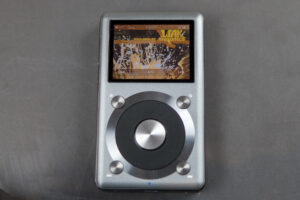 (UI) of the X3 shows a lot of refinement on FiiO’s part. Things have come a long way since the original X3. The menus are cleanly laid out with simple and obvious icons (for the most part) and easy navigation via the scroll wheel and centre button. You can also choose from 6 different themes which offer everything from minor variations to the stock FiiO look through to denim, wood panelling, and a really sexy cross-hatched charcoal texture. There’s no doubt that the interface of the X3K is as good as anything else I’ve seen to date – not better, but as good – it’s really excellent now.
(UI) of the X3 shows a lot of refinement on FiiO’s part. Things have come a long way since the original X3. The menus are cleanly laid out with simple and obvious icons (for the most part) and easy navigation via the scroll wheel and centre button. You can also choose from 6 different themes which offer everything from minor variations to the stock FiiO look through to denim, wood panelling, and a really sexy cross-hatched charcoal texture. There’s no doubt that the interface of the X3K is as good as anything else I’ve seen to date – not better, but as good – it’s really excellent now.
Features
The X3K packs a few nice features that some users expect and some don’t ever use.
Equaliser
The graphic equaliser is a 10-band affair that’s easy to adjust, has a nice range of presets and works well on normal resolution tracks – it doesn’t work on high bit rate files (i.e. DSD, 192/24 FLAC, etc.) just like the X5, most likely due to the processing power required. This isn’t a big issue for me because I’m a non-EQ kind of guy, but that might bug some people.
Balance Control
 Balance control is in demand more than you might think, particularly from people with a unilateral hearing loss (i.e. one ear hears better than the other) so the X3K will no doubt win some sales with that feature when combined with all the other things it has going for it.
Balance control is in demand more than you might think, particularly from people with a unilateral hearing loss (i.e. one ear hears better than the other) so the X3K will no doubt win some sales with that feature when combined with all the other things it has going for it.
DAC Capability
The X3K can also operate as a USB DAC with Windows (using an additional ASIO driver) and with Macs. It can even play DSD files from your computer via an additional software plugin so that’s great news for people who are out and about with a laptop and a taste for great sounding music.
Miscellaneous Features
Finally, here are a few other things that the X3K has going for it:
- Headphone detection allows the X3K to pause playback when the headphones are unplugged
- Hibernation mode allows a low-power sleep mode that conserves battery, but also provides near instant resuming of playback
- Inline earphone control support means you can play, pause, and change the volume from your earphone cord (for compatible earphones)
- A nice range of accessories including a sexy looking brown leather case
So, all up the X3K looks to be a winner. It has a great feature set, is extremely well-built, extremely well priced, and offers functionality and compatibility on par with much pricier players. So does it sound like it costs or does it sound like it looks on paper?
Sound Quality
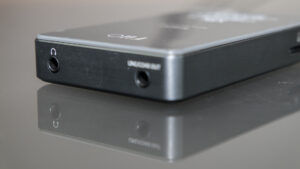 Well, to answer that question I’d have to say it’s a mixed bag which errs towards very, very good
Well, to answer that question I’d have to say it’s a mixed bag which errs towards very, very good
There is no doubt at all that the X3K sounds great – better than the original X3 and definitely better than the X1 and I’m almost convinced that this is the best bang-for-buck sound you can get, but it’s not definitive and your personal tastes will come into the equation.
Rather than talk about the bass and treble and all those fine details that are really hard to differentiate when trying to compare different players, let me break down the overall listening experience from the X3K compared to the same experience (same tracks, etc.) on other devices. I’ll also discuss how the X3K compares with varying loads, from sensitive IEMs through to challenging headphones.
Before I get into specifics, let me say that the X3K offers a quite neutral experience. It’s not analytical or cold, but it also doesn’t carry the same warmth of the original X3. The X3K is a player with nicely balanced sound that doesn’t jump out as too warm, too cold, or too much of anything really and that’s excellent – it’ll let your earphones sound the way they’re meant to rather than adding too much colour in the player. Nice work FiiO!
With IEMs
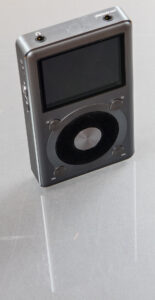 With the hyper-sensitive Shure SE846 there is noticeable hiss from the X3K. Now, I’m a bit hyper-sensitive to hiss so some people won’t even notice what I’m hearing and it’s not an issue once the music’s playing, but it’s there. I should also mention that there is a little bit of hiss from many players on the market, including the outstanding Shozy Alien, HUM Pervasion (to a lesser degree), and even my faithful iPod Video so the X3K isn’t bad in this regard – it’s actually quite normal.
With the hyper-sensitive Shure SE846 there is noticeable hiss from the X3K. Now, I’m a bit hyper-sensitive to hiss so some people won’t even notice what I’m hearing and it’s not an issue once the music’s playing, but it’s there. I should also mention that there is a little bit of hiss from many players on the market, including the outstanding Shozy Alien, HUM Pervasion (to a lesser degree), and even my faithful iPod Video so the X3K isn’t bad in this regard – it’s actually quite normal.
With the higher impedance Noble Kaiser 10s, the hiss is gone so it’s likely only an issue with super low impedance IEMs (like the SE846) and possibly with some of the more hiss-prone IEMs like the FitEar TG!334, but I don’t own a pair to test unfortunately.
Power wise, the X3K’s 120-step, dual gain volume control means that there’s plenty of range to work with in low gain mode. I found myself at around 40-50 on the volume control for IEM listening in a quiet room.
With Headphones
For this test, I tried the Thinksound On1s (50 ohms) , Beyerdynamic DT1350s (80 ohms), and Ultrasone HFI-680s (75 ohms). Of this lot, the full-sized HFI-680s are the most demanding to drive and I do feel like the X3K struggled with them a little. They still sounded good, but not their best – highs were a bit edgy and the bass was lacking from what is quite a punchy headphone.
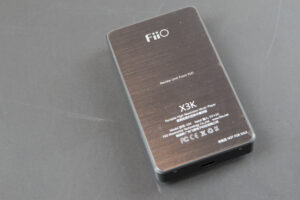 With the more portable (i.e. smaller drivers) DT1350 and On1, the X3K sounded great, providing plenty of power and authority to the sound. I was getting up towards volume 80 / 120, but that’s still on low gain so there’s no shortage of volume with the X3K – it will comfortably drive any headphone you’re likely to use in portable situations, but you may find an amp helpful for more desktop style headphones and that’s where the line out comes into play which I’ll discuss shortly.
With the more portable (i.e. smaller drivers) DT1350 and On1, the X3K sounded great, providing plenty of power and authority to the sound. I was getting up towards volume 80 / 120, but that’s still on low gain so there’s no shortage of volume with the X3K – it will comfortably drive any headphone you’re likely to use in portable situations, but you may find an amp helpful for more desktop style headphones and that’s where the line out comes into play which I’ll discuss shortly.
So, the X3K plays very well with all but the most sensitive / hiss-prone in-ears and even then it’s quite acceptable even if not perfect. It also offers plenty of grunt for portable and efficient headphones, so as the portable player it’s designed to be, the X3K ticks all the right boxes so let’s discuss how it sounds compared to some other players you might have heard of or read about.
Versus the iPod Video (5.5G)

The 5.5G iPod Video is generally considered to be the best of the bunch of all of the iPods so it’s a good place to start even though you can’t buy them any more.
I should mention that the iPod is instantly handicapped here because mine isn’t running RockBOX and so I load it with 320kbps MP3 files while the X3K has the same tracks in FLAC – this shouldn’t be a fair fight…
The iPod is still impressive given its file format handicap and age. The sound is musical, spacious and well-presented – this is going to be a battle…
The X3K brings a little more refinement to the sound and the separation is also better – everything is just cleaner. The sound from the X3K is also fuller with more weight and a little more body, but here comes the FiiO Achilles heel (in my opinion)… the sound from the X3K is flat – lacking a sense of depth and space. Technically, the sound is rendered perfectly well and is cleaner and sharper than the iPod, but it’s all painted onto a flat canvas that stretches from left to right. If I had to choose one player over the other, I’d choose the X3K without a second thought, but I really wish FiiO could start to focus a little more on the subjective presentation of their sound, specifically a spatial and organic sound, rather than just technical accuracy.
Versus the Shozy Alien
 These are two very different players. The X3K is an audio Thermomix that does everything for you in an audio sense – there’s not a feature missing. The Alien, on the other hand, is like a mixing spoon – it does one thing and one thing only, but it does it really well.
These are two very different players. The X3K is an audio Thermomix that does everything for you in an audio sense – there’s not a feature missing. The Alien, on the other hand, is like a mixing spoon – it does one thing and one thing only, but it does it really well.
Once again, there is a slight format difference here, but it’s a bit more even this time. The Alien is loaded with wave versions of the files (44.1/16) and the X3K has identical FLAC versions. The Alien’s default starting volume also tends to be quite loud so I was careful to rein it in to prevent the Alien sounding more dynamic as a result of louder volume.
This battle was a bit closer in terms of clarity, but the X3K had a slight edge in terms of bass extension and control. The bass from the X3K is really tight and punchy which keeps the music sounding energetic and dynamic.
Overall, the X3K is probably slightly more technically proficient than the Alien, but the Alien might still be the more engaging listen due to its organic presentation and sense of space – the number one strength of the Alien and where it beats basically every player on the market. Honestly, I would have a hard time choosing between these two because the Alien sounds a touch more engaging overall, but the X3K performs better technically and has so many more features. This one would come down to a purely personal preference for clean, detailed sound and loads of features versus a slightly more engaging and analogue sound in a stripped back, purist player. For auditory enjoyment alone, the X3K edges ahead on some tracks while the Alien creeps ahead on others.
Versus the HUM Pervasion
 I’m turning up the heat a bit now. The Pervasion costs roughly double the price of the X3K and should be noticeably better.
I’m turning up the heat a bit now. The Pervasion costs roughly double the price of the X3K and should be noticeably better.
These two are surprisingly close in sound and that’s a huge compliment to the X3K. In terms of signature they are almost identical, but the Pervasion wins in two key areas. Firstly it brings a greater sense of space into the soundstage despite the Pervasion being a little limited in this regard. Secondly, the sound from the Pervasion has a level of refinement that the X3K can’t quite match.
Listening to these two side-by-side they sound like they are related. If you heard the X3K and then the Pervasion you could easily think that the Pervasion was the X5, the natural next step from the X3K, but the Pervasion is miles better than the X5 and I am fairly confident that the X3K might be better than it’s older, bigger brother, but I don’t have an X5 any longer to compare – all I know is that the X5 didn’t please my ears quite as much as the X3K seems to be.
Given that the X3K packs features like USB DAC functionality, coaxial out, and a few other subtle things lacking from the more specialised Pervasion, the X3K has a compelling case, but the Pervasion is still clearly better from a pure audio quality and engagement / enjoyment perspective.
DSD Performance
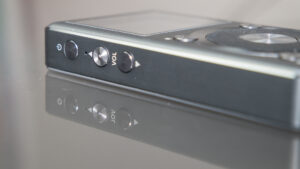 The DSD performance of the X3K is seamless and the player skips quickly between formats with no delays or pops or crackles so if you load up a mixture of MP3, FLAC, and DSD files you’ll find a glitch-free listening experience.
The DSD performance of the X3K is seamless and the player skips quickly between formats with no delays or pops or crackles so if you load up a mixture of MP3, FLAC, and DSD files you’ll find a glitch-free listening experience.
I did notice a hint of processor noise (or something similar) at the beginning of the DSD tracks when things were quiet. It’s completely inaudible when the music is playing and therefore doesn’t really interfere, but I never noticed that type of noise with PCM format files.
Comparing identical tracks in DSD and FLAC (I converted the DSD file to 192/24 FLAC to ensure identical mastering), the DSD may have a slight edge in refinement, but it’s so close as to be not worth debating. In short, the X3K provides an equivalent experience regardless of using FLAC or DSD which is great – you don’t want a player that sounds noticeably better with one format because it’ll have you converting or re-buying all your music and that’s a pain.
Line Out Quality
 The line out from the X3K is clean and detailed with no significant colouration. As a portable source to pair with an external amp, the X3K is very good. That’s not to say the X3K needs an amp, but it’s line out is ‘up to scratch’ if you want to use an amp.
The line out from the X3K is clean and detailed with no significant colouration. As a portable source to pair with an external amp, the X3K is very good. That’s not to say the X3K needs an amp, but it’s line out is ‘up to scratch’ if you want to use an amp.
To get a better handle on just how good it is, I compared it directly (and unfairly) with my Matrix X-Sabre DAC. I only did this because it was an easy way to have identical tracks playing that I could switch between instantly, but the results were astounding. The X-Sabre has an edge in detail and subtle cues (including depth and spatial cues), but it’s a razor’s edge. The X3K comes amazingly close to the X-Sabre in terms of signature, clarity, and overall subjective quality. That’s right, this pocket-sized, $250 DAP stands toe-to-toe with a $1200+ desktop DAC and manages to lose only about 10% to the goliath in this match-up!! That’s crazy and puts the X3K’s DAC / line-out performance on par with or above the Pervasion, iFi Nano iDSD (and possibly Micro iDSD) and easily beats multiple desktop DACs that I’ve tried – wow!
The only thing holding the X3K back from perfection in this area is the tiniest lack of refinement around the edges of the high notes. It’s a subtle distinction, but one worth making – the X3K doesn’t beat top end DACs like the X-Sabre, but it has no right to be even playing in this ball park and that’s what makes it supremely impressive.
Summary
 Coming from owning the very good X5 and reviewing the good, but not exceptional X1, I really didn’t expect huge performance from the X3K and perhaps even came into this review with a slightly negative bias, but I’m pleased to say that the X3K had everything required to completely change my preconceptions and convert me towards fandom. I’m not quite a fanboy now because the HUM Pervasion is still my dream player for the time being, but I have immense respect for the X3K and what FiiO have achieved and it has me very excited to see and hear the upcoming X5 2nd Generation and the first generation of the flagship X7.
Coming from owning the very good X5 and reviewing the good, but not exceptional X1, I really didn’t expect huge performance from the X3K and perhaps even came into this review with a slightly negative bias, but I’m pleased to say that the X3K had everything required to completely change my preconceptions and convert me towards fandom. I’m not quite a fanboy now because the HUM Pervasion is still my dream player for the time being, but I have immense respect for the X3K and what FiiO have achieved and it has me very excited to see and hear the upcoming X5 2nd Generation and the first generation of the flagship X7.
If you’re on the hunt for a compact, high quality, fully featured audio player you should absolutely, 100% check out the 2nd generation of FiiO’s X3 – it might be the most impressive product made by FiiO so far and that’s saying something!
Edit 18th August 2015: While the X3ii remains an excellent device, I have to admit to be a little disappointed with the X5ii. I was planning a full review of the X5ii, but elected to include it in a multi-DAP shootout with the Cayin N6, HUM Pervasion and iBasso DX90 and the results didn’t really warrant a separate review. In short, the X5ii was a little disappointing. It has the really nice interface of the X3ii, the excellent build quality and design, but a lack-lustre sound compared to the cheaper X3ii. To me it’s a side-step in sound quality from the original X5. In terms of price-to-performance, the X3ii seems to me to be far better value. I didn’t have both the X3ii and X5ii at the same time, but based on my separate time spent with both I would buy an X3ii, not an X5ii.


